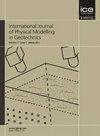Static model tests on mechanical behavior of assembled multi-step cantilever walls
IF 1.2
4区 工程技术
Q4 ENGINEERING, GEOLOGICAL
International Journal of Physical Modelling in Geotechnics
Pub Date : 2023-08-29
DOI:10.1680/jphmg.22.00076
引用次数: 0
Abstract
Assembled multi-step cantilever retaining walls is a new type of light retaining structure, which can be quickly installed in situ and suitable for high fill earthworks. In order to investigate its mechanical behaviors fully to support practical analysis and design of the novel wall, a series of laboratory model tests are conducted for three-step cantilever walls retaining cohesionless filling under various strip surcharges on the top of the backfill. Test results indicate that lateral earth pressure on the highest-step wall member increases with the depth on the upper two-thirds segment of the wall stem, whereas it presents multi-step polyline distribution mode on the lower two steps. Except for the highest-step wall member, the earth pressure on the upper part of each member stem shows some reduction effect due to shielding action of the upper heel plate inserted in the backfill. The lateral earth pressure on the wall obtained by numerical simulation via FLAC3D is consistent with the measured one in terms of the whole variation tendency. Horizontal displacement of the whole wall takes on a unimodal profile with relatively higher values at the middle height of the wall. Increasing the bench width is helpful to reduce the lateral earth pressure on the wall stems and setting up shear key beneath the footing plate of the lowest-step member can reduce the wall displacement by up to 51%.组合多台阶悬臂墙力学性能的静力模型试验
拼装式多台阶悬臂挡土墙是一种新型轻型挡土墙结构,可快速就地安装,适用于高填方土方工程。为了充分研究其力学行为,为新型墙体的实际分析和设计提供依据,对充填体顶部不同条状附加物条件下的三阶悬臂墙进行了一系列室内模型试验。试验结果表明,在墙杆上三分之二段,最高阶墙体构件侧土压力随深度增加而增大,而在墙杆下两段则呈多阶多线形分布。除最高阶墙体构件外,各构件杆部上部土压力均因插入回填体的上跟板的屏蔽作用而有一定的减小作用。FLAC3D数值模拟得到的墙侧土压力总体变化趋势与实测值一致。整个墙的水平位移呈单峰型,在墙的中间高度处相对较高。增加台阶宽度有助于减小墙体杆侧土压力,在最低阶构件基础板下方设置剪力键可使墙体位移减小51%。
本文章由计算机程序翻译,如有差异,请以英文原文为准。
求助全文
约1分钟内获得全文
求助全文
来源期刊

International Journal of Physical Modelling in Geotechnics
ENGINEERING, GEOLOGICAL-
CiteScore
3.60
自引率
15.80%
发文量
26
期刊介绍:
International Journal of Physical Modelling in Geotechnics contains the latest research and analysis in all areas of physical modelling at any scale, including modelling at single gravity and at multiple gravities on a centrifuge, shaking table and pressure chamber testing and geoenvironmental experiments.
 求助内容:
求助内容: 应助结果提醒方式:
应助结果提醒方式:


